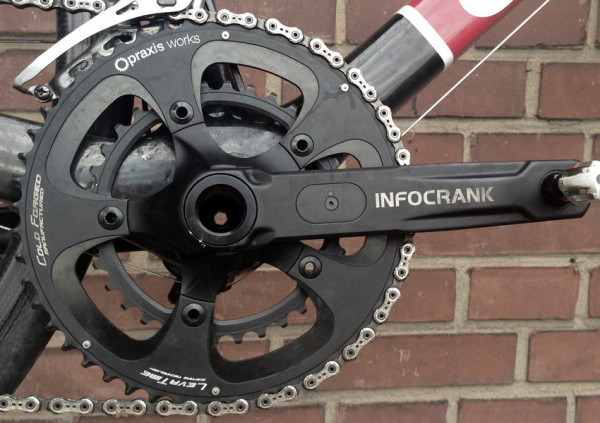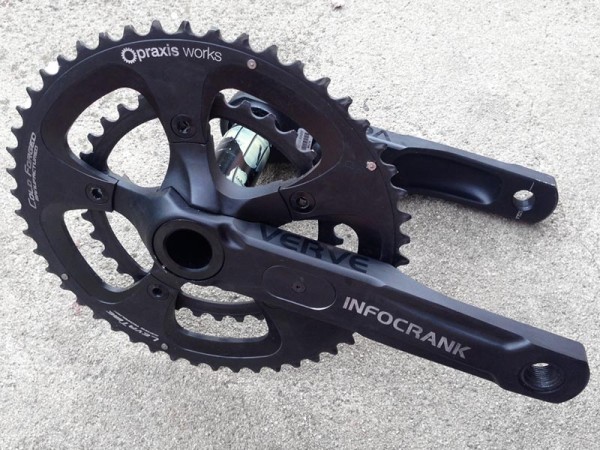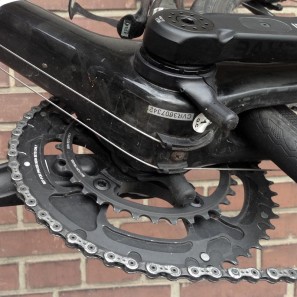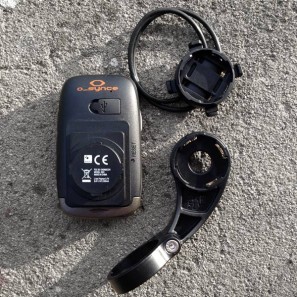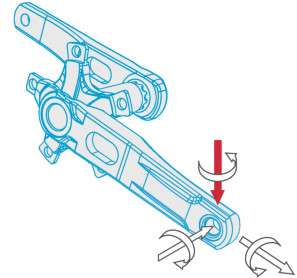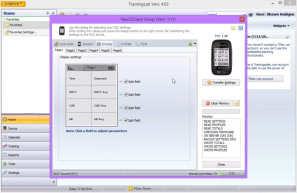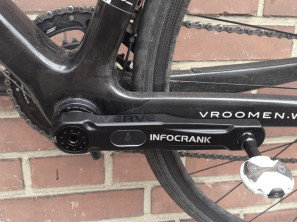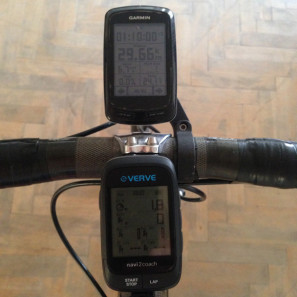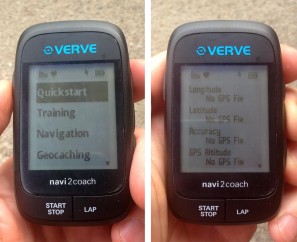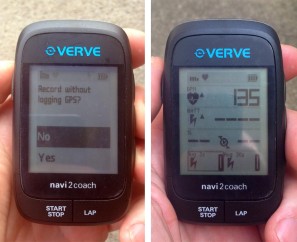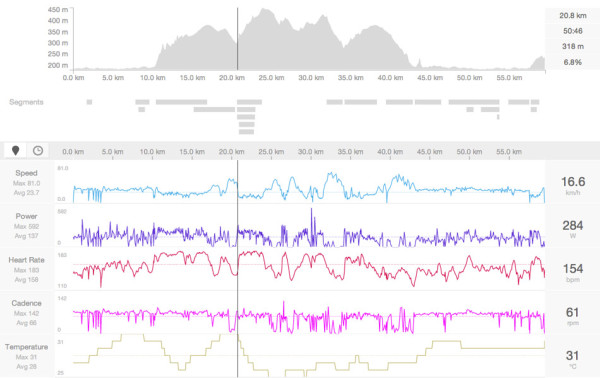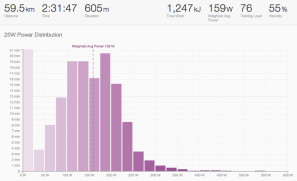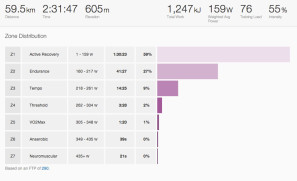As we introduced them to you this spring, Verve Cycling is now delivering the production version of their new power metering crankset, the Infocrank. The power meter can now be ordered online, and is shipped consumer-direct from either their EU, US, or Oceania distribution hubs. Then through a network of worldwide Affiliates, they can work with you to make sure you take full advantage of the power meter’s training capabilities.
Having recently finished final beta testing and now been delivered to early supporters, we had the unique opportunity to borrow a set of the power metering cranks directly from Verve Cycling’s president for just over a week to see what customers could expect. Bryan Taylor lent us his personal Cervélo R3 with the Infocrank installed while he was traveling on business, giving us a chance to go through the new setup process with the included O_synce Navi2coach GPS computer, as well as to pair it with a standard Garmin Edge computer. We tested out the cranks on a few regular mid-length group and solo road rides, as well as giving it a go on some gravel, and even a bout on the indoor trainer. The goal was less about testing the accuracy of the power meter (a point where Verve seems to excel, btw) and more about how a rider might set up and actually use the Infocrank.
Come past the break for the full details and real world weights.
Tech Details & Actual Weights
One of the first things to notice is that Verve focused their involvement on what they do best and that is the technology of building a high quality, precision power meter directly integrated into the load path of their own optimized crankset design. From the beginning Verve honed in on the science behind power metering with a single goal to “measure power accurately”, something they were disappointed to discover was not easy to find on the cycling market where in-lab and real-world results didn’t always agree or remain consistent.
Verve pairs their base cranks with the exceptionally well received Praxis Works forged chainrings and a Praxis bottom bracket (M30 or BSA) leaving those parts to the specialists. They also includes the Navi2coach head unit from German company O_synce (something of an analogue to the Garmin 500) where they were able to have greater input into the development of the user interface and the use of key bilateral metrics.
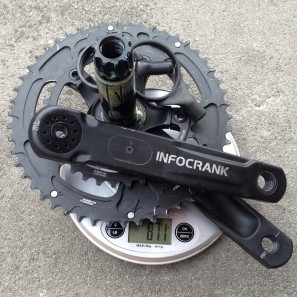
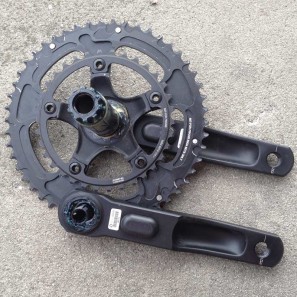
The 694 gram-claimed Infocrank is a forged 6000 series aluminum crankset with an integral 110 BCD compact spider and machined recesses in each arm housing individual left and right power metering modules.
The cranks are available in 170, 172.5, and 175mm lengths, in a black anodized finish.
The Praxis chainrings are offered in either 50/34 compact or 52/36 semi-compact.
The 30mm Praxis bottom bracket is compatible with either BSA, BB30, PF30, or BB86 frames.
Our sample setup weighed 871g total including the 135g Praxis rings, 10g chainring bolts, and 30g magnets (just 2 grams heavier than the claimed weight.)
Paired with the included cadence magnets (both BB cup mounted magnets like we used and an adhesive-mount magnet are included), the crank translates direct torque (Nm) measurement into power (W) and includes cadence (rpm) tracking. With left and right measurement the Infocrank allows power balance analysis, as well as per pedal torque and pedaling efficiencies not often tracked by other power meters.
The Navi2coach computer is fitted with a 4-point 1/8 turn locking mount exclusive to Verve (and similar to but not compatible with Garmin’s 1/4 turn Edge mount). The Verve-branded computer includes a rubber band handlebar/stem mount and a Barfly out front style mount for 31.8 bars.
A unique feature of the Infocrank is the configuration and factory calibration of the strain gauges directly in the load path between pedal input and crank rotation, meaning there is no need to ever recalibrate the crank during normal use, greatly simplifying operation versus the competition and removing a common opportunity for user error. The design and layout of the strain gauges automatically eliminates data drift over time, compensating for temperature and pressure changes, ensuring that it reliably measures power in all conditions. As a result, Verve is very adamant in reminding that the “accuracy of an InfoCrank will not change over time. This means you DO NOT need to Calibrate using your bike computer, ever.”
The Infocrank power meter was developed in collaboration with the Australian Institute of Sport, who has been responsible for testing accuracy and drift, the defining hallmarks of the Infocrank. By incorporating a Wheatstone bridge arrangement of its strain gauges not sensitive to drift, Verve quotes a resulting accuracy of ±0.2 Nm < 20 Nm and ± 1% > 20 Nm.
That means ±1% for measurements of about 160W and above, while independent tests have measured the max deviation of just over half of that.
With variation regularly ±10% between many of the current power meters on the market, the Infocrank may be a market leader in terms of true accuracy. Always concerned with real-world accuracy, Verve’s head engineer put together a short manifesto on “Why a power meter that’s relatively good is just not good enough.“ Have a look there for an interesting read on the science behind the Infocrank.
Data transfer is wireless by the ANT+ standard allowing pairing with almost any cycling computer, although not all on the market can benefit from full bilateral data streams. Each power measuring module is powered by a user-replaceable button cell battery with a 500 hour operational life.
Verve works closely with their Affiliate network to continuously develop and deliver firmware updates to incorporate added functionality with the latest ANT+ protocols to meet end user needs. Also working with computer provider O_synce, they are one of the first systems to include the newly developed bilateral Torque Efficiency (per pedal) and Pedaling Efficiency (per pedal) protocols.
Pricing for the complete power meter is 1533€/1260£/$1750/A$1999, depending on your market.
It includes a set of forged Praxis chainrings, a Praxis bottom bracket, the Praxis BB installation tool, both stick-on and BB-mounted cadence magnets, and the O_synce Navi2coach GPS head unit. All Infocranks include a 2 year warranty.
Initial Setup
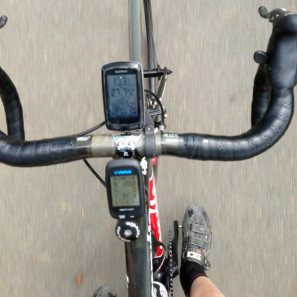
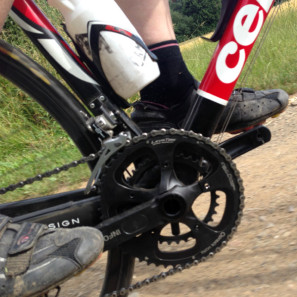
Our goal with the growth of the power meter market was to see how a typical rider might set up and use the Infocrank. The test unit we received was already installed, but we needed to set up a couple of GPS head units from scratch. We first started with the new Verve-branded Navi2coach that comes with the Infocrank, and while its user interface seemed to take a little while to get the hang of, pairing the power meter was easy and straightforward. What was a bit more complicated was setting up the workout displays. O_synce has a nice looking piece of software called trainingLab to adjust the settings from your home computer, but unfortunately it is not Mac-friendly so I stuck to doing everything through the GPS’s interface to see how easy it would be. (Verve Cycling has a pretty useful video tutorial on their youtube channel that shows you how to set up the display pages with Training Lab, and also offers some good insight into which metrics will be helpful for on-the-bike training.) With only four navigation buttons and abbreviated menu titles it took several minutes to get all of the metrics I wanted displayed, but once set up it functioned flawlessly. As a comparison, I also paired the power meter to a Garmin Edge 800, which was also simple and a bit quicker using an interface I was more familiar with.
Even though we didn’t need to install the crankset, a quick removal/reinstall via its self extracting bolt to weigh the system showed me that regular users should have no problems with installation. It is if anything more straightforward than many cranksets on the market. Plus, Verve has prepared a very concise and helpful set of installation videos on their youtube channel that should alleviate any concerns.
Ride Review
For our short test period the weather faired well, so we didn’t get past dusty gravel roads and the occasional puddle to see how the power meter stood up to the elements. Verve does recommend against direct pressure washing as is standard for power meters, but the crankset is IPX7 rated (to 1m) so water infiltration won’t be a regular concern. The flush installation of the power metering modules inside of the stout aluminum arms should also keep the sensitive parts safe. One minor concern we might have is that these power metering modules are located on the crank arm where heel draggers tend to scuff their cranks. It is likely not a concern (again being flush, or actually very slightly recessed, and protected by the aluminum arms), but if you pedal with heels in it would probably be worth keeping an eye on the covers over time for any significant wear.
From a functionality perspective the Infocrank was easy to use and worked perfectly through our test. I also certainly appreciated the inclusion of well-trusted parts from Praxis, which ensured good stiffness and excellent shifting that simply disappeared under pedal.
The oversized forged crank arms themselves seemed stiff enough, as does the 30mm spindle, although probably not quite as stiff as a pair of high-end carbon cranks. The bike I tested had a traditional threaded BB, and unsurprisingly the PF/BB30 systems are rumored to be even stiffer.
I was surprised and sometimes annoyed at how slow the Navi2coach was to pick up a GPS signal here in central Europe compared to the Garmin 800, which tends to be slow itself, even after having been used for several days at the same start point. The 800 sometimes took 10 seconds more than a Garmin Edge 200 I had on hand, while the Navi2coach was up to 25 seconds slower. While just an annoyance, my impatience meant that data collection started a couple hundred meters after I started each ride. Of course you could start without a GPS signal, and I had no problems collecting power, heart rate, and cadence data when riding inside on the trainer.
Subjectively, we got a lot of curious and strange looks from those we rode with. Some thought the crankset looked very bulky or too angular, while I personally like its somewhat industrial aesthetic. Even though the Navi2coach computer was totally functional, the lack of real mapping or a touchscreen interface were turnoffs for me, and being used to an Edge 800 I would prefer to have the power meter offered individually. I am a big fan of compact cranks, but again I was asked why it doesn’t come in a standard road 130BCD since that’s what most ‘racers’ use. I don’t have much of a response to that except to say Verve is working on it, so keep your eyes open for news in the near future.
With all the live power data on the display, the right/left power balance feature was certainly interesting to watch. I was most intrigued how my power output, both instantaneous and 3-5 second averages, stayed very unbalanced depending on which leg I started with for a hard sprint or out of the saddle climbing effort. It led me to look at how to be smooth more quickly after that first big pedal stroke. But in general seeing as how my overall power output was pretty well balanced (within 5-10% on average), there really wasn’t a real benefit for me vs. having only single sided measurement.
In the end what did I think about having real accurate power displayed at my fingertips?
Well, as someone who only begrudgingly trains part of the year so that I don’t suffer on a few key events and then again through cyclocross season, I think detailed display of the data was distracting. Unless you train with power year-round, real live power output is just an abstract number, and over the top for most users. It was nice to have the power balance numbers and the 3 and 30 second averages to show me what my real power output was on some familiar extended climbs and flat Strava TT segments, but the amount of data you can display is pretty overwhelming. I think in setting up the computer, simplicity in what you display is key.
Now with all of the data generated and the repeatability and accuracy that Verve is promising, someone seriously training or racing at a high level could really benefit from some deep data analysis. One of the simple uses of all that power data is to passively drop it all into some training software like Training Peaks, Golden Cheetah, or even Strava to quantifying each ride’s Training Load which can help track your fitness over time and even plan rest periods. But to truly benefit from that rich data I think you would really need to combine the power meter with a professional coach and a full-time training schedule. That is one of the potential great benefits of Verve’s Affiliate program. These training professionals with expertise on the Infocrank can help you decide if you want to make the jump from amateur cyclist and data collector to a serious competitive cyclist with their further services.
I personally feel like detailed power at my fingertips is more than I need, until I decide to get a bit more serious with training. I imagine that when cyclocross season comes around I’ll realize how much it would have helped me, so until then I will just need to find a more competitive friend to buy an Infocrank that I can borrow a couple of times a year to benchmark myself. Actually, I think I already have someone in mind.
